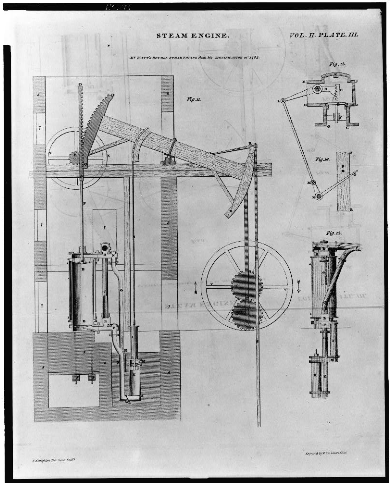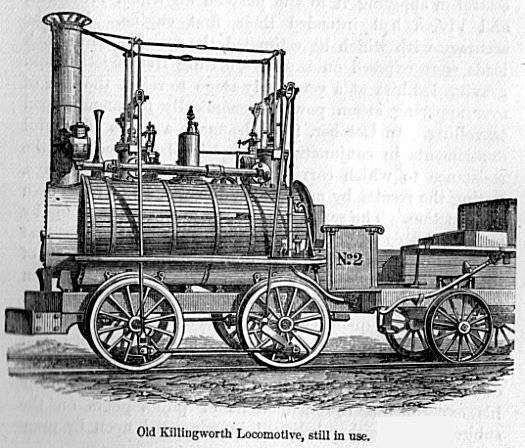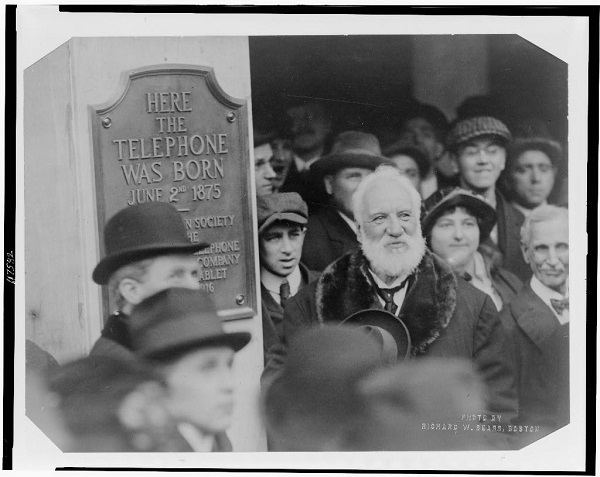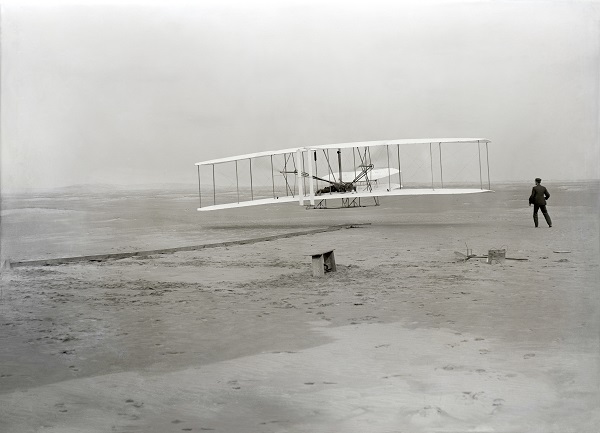Many new and innovated inventions were created during the Industrial Revolution. These inventions helped further spur the industrial revolution and improved farming, manufacturing, transportation, communication, health, public safety as well as the economy.
Each invention and technological advancement helped spur future inventions so the timeline of the industrial revolution and where these inventions fit in the timeline is important to know.
The following is a list of inventions of the industrial revolution:
Newcomen’s Steam Engine:
Newcomen’s steam engine was invented by Thomas Newcomen in England in 1712. The steam engine pumped water using a vacuum created by condensed steam. The engine was an important invention because it drained water out of deep mines, thus making it vital to the mining industry.
Flying Shuttle:
James Kay invented a simple weaving machine called the Flying Shuttle in Languedoc, France in 1733. Before the invention of the shuttle, fabric was woven by two weavers passing a shuttle back and forth between them. The flying shuttle mounted the shuttle on wheels in a track and used paddles to push the shuttle side to side when the weaver jerked a cord. This reduced the number of necessary weavers to one and greatly sped up the process so one weaver could weave fabric more quickly than two.
Spinning Jenny:
James Hargreaves invented the spinning jenny in Stanhill, England in 1764. The spinning jenny allowed workers to produce multiple spools of thread at the same time. By turning a simple wheel on the machine, the operator could spin eight spindles of thread at once, instead of just one. As the technology advanced, the machine was able to spin between 80 and 120 spindles.
Watt Steam Engine:
James Watt patented his revision of the steam engine in Scotland in 1769. Watt’s engine featured a separate condenser which filled the power cylinder with steam as the piston moved to the top so that it was immediately ready for another stroke instead of having to wait for the power cylinder to warm up again. This made the steam engine much faster and efficient, using only half as much coal to produce the same amount of power.

Water Frame:
The water frame was patented by Richard Arkwright in England in 1769. Although water frames have existed since ancient Egypt, Arkwright designed a model that could produce cotton thread. The machine was capable of spinning 96 strands of yarn at once and didn’t require any technical skills to operate.
Spinning Mule:
Samuel Crompton invented the spinning mule, which could spin multiple spools of thread and yarn at once, in England in 1779. The machine was named after a mule because it was a hybrid machine that combined two earlier inventions, the spinning jenny and the water frame. The spinning mule was particularly useful for the production of muslin.
Power Loom:
Edmund Cartwright invented the power loom, which replaced the flying shuttle, in England in 1785. The power loom is a mechanized loom that used water power to speed up the weaving process. The initial power loom was not very efficient or commercially successful and was later improved upon by Scottish inventor William Harrocks and American inventor Francis Cabot Lowell. As a result of the improvements, the power loom was commonly used after 1820.
Cotton Gin:
The cotton gin was invented by Eli Whitney in Savannah, Georgia in 1793. The cotton gin separated cotton fibers from their seeds more quickly and efficiently than doing it manually. This revolutionized the cotton industry but it also greatly increased the demand for cotton workers in the south which led to the growth in slavery.
Ice Box:
Thomas Moore invented the first wooden ice box in Maryland in 1802. The ice box was a simple wooden box lined with insulating materials such as tin or zinc with a large block of ice in a compartment near the top of the box. The outside of the box was lined with rabbit fur or other insulating fabrics. The ice box allowed for perishable food to be kept fresh for longer than before without the need for drying, smoking or canning the food.
Puffing Devil:
Richard Trevithick patented his steam-powered locomotive called the “Puffing Devil” in Camborne, England in 1802. The contraption was the first steam-powered train of its kind.
Steam Engine Locomotive:
George Stephenson patented his steam engine locomotive that ran on rails in 1814. Stephenson’s locomotive was used to haul coal out of the mines in Killingworth, England.

Mechanical Reaper:
Cyrus McCormick invented the mechanical reaper, a mechanical horse-drawn reaping machine, in Walnut Grove, Virginia in 1831. The machine was used to harvest crops much faster and more efficiently than hand reaping. McCormick’s reaper differed from earlier reaper inventions because it had safety guards, reciprocating (back and forth-moving) blades, a divider to separate cut and standing grain and a revolving reel to gather the cut grain onto the rear of the machine, so it could be raked off onto the ground and later bound.
Telegraph:
Although Samuel F.B. More didn’t technically invent the electric telegraph, since many others had claimed to invent the first electric telegraph by 1838, Morse was the first to get federal funding for the invention. The telegraph was important because it allowed people to communicate quickly over long distances by transmitting electrical signals over a wire laid between stations. In 1843, Morse built a telegraph system from Washington D.C. to Baltimore, Maryland with financial support of Congress and he sent the first telegraphic message on May 24, 1844, which said “What hath God wrought?”
Steel Plow:
A blacksmith named John Deere invented the steel plow in Illinois in 1837. The steel plow was revolutionary because farmers were using cast iron plows at the time which the soil would stick to, forcing the farmer to stop frequently to clean off the plow. The steel plow could be polished so that soil would slide right off it. The steel plow was a huge commercial success and John Deere plows and farm equipment are still popular today.
Sewing Machine:
The sewing machine was patented by Elias Howe in Cambridge, Massachusetts in 1846. Howe’s sewing machine differed from an earlier model of sewing machine invented by Walter Hunt because it created a lockstitch by using thread from two different sources. The lockstitch was created by a threaded needle being pushed through the fabric and creating a loop on the other side where a shuttle on a track slipped the second thread through the loop, creating the lockstitch.
Vulcanized Rubber:
Charles Goodyear patented vulcanized rubber in 1844. The formula involved mixing sulfur with the liquid latex and then heating it, which created a more pliable stable form of rubber that wouldn’t melt in hot weather or crack in cold weather. Goodyear had invented the formula five years earlier in Massachusetts, where the first rubber company in the country Roxbury India Rubber Company was located, but it took until 1844 to patent it.
Elevator Safety Brake:
Elisha Otis invented a safety brake for elevators in 1853. Elevators were in use throughout the 1830s and 1840s in America and Europe but were operated with hemp ropes that would sometimes break and kill passengers.
The safety brake used a wagon spring that was attached to the elevator platform as well as the lifting cable. The spring was kept in place by the pull of the lifting cable but if the cable broke, the pressure on the spring was released causing the spring to snap open and hook onto the saw-toothed beams that Otis had installed on either side of the elevator shaft, bringing the elevator to a stop.
The invention transformed real estate in America, making the top floor in tall buildings highly coveted because it was away from the noisy city streets, and eventually paved the way for modern skyscrapers.
Bessemer Process:
The Bessemer Process for making steel was invented by Henry Bessemer in 1856. The process allowed for the mass production of inexpensive steel and involved removing impurities from the iron by oxidation by blowing air through the molten iron.
Telephone:
Alexander Graham Bell invented the telephone in Boston, Massachusetts in 1875 and patented it in 1876. Bell was not the first inventor to come up with the idea of the telephone though. Antonio Meucci and Elisha Gray both invented earlier versions of the telephone but Bell was the first one to patent it and transfer the idea to a commercial product. Both Bell and Gray’s telephones worked by using a liquid transmitter.

Bell continued to improve the electromagnetic phone though and soon abandoned the liquid transmitter design, never using it in his first public demonstration of the phone in Salem, Massachusetts in 1877 or in commercial use.
Phonograph:
The phonograph was invented by Thomas Edison in New Jersey in 1877. The phonograph was a device that could record and play sounds. The sound was recorded by speaking into a cylinder that was attached to the device while turning a handle. The sound waves made a needle inside of the device vibrate which created a groove onto a piece of tin foil. The sound was played by rotating the tin foil record while a playback stylus traced the groove on the record which vibrated and faintly reproduced the recorded sound.
Incandescent Lightbulb:
Thomas Edison invented and patented the first practical incandescent lightbulb in New Jersey in 1880. Edison’s lightbulb improved upon earlier lightbulb inventions by other inventors. Edison improved upon the earlier designs by using a carbon filament which made the bulb last much longer and didn’t require a high electric current to operate.
Induction Electric Motor:
The induction electric motor was invented by Nikola Tesla in New York in 1887 and patented in 1888. The motor consisted of three parts: a rotor, a stator and coils that would convert electrical energy into mechanical energy with the use of electro magnetic induction. This motor is considered one of the most important inventions in modern history and kicked of the second industrial revolution by greatly improving energy generation efficiency and making long-distance distribution of electricity possible.
Roller Coaster:
The Roller Coaster was invented and patented by Edwin Prescott in 1898. Prescott called his invention a centrifugal railway, but later renamed it the Loop-the-Loop, because it consisted of a cart on a track with a circular loop. The roller coaster used centrifugal force to keep the cart on the track as it went around the loop.
Airplane:
The airplane was invented by Orvile and Wilbur Wright in 1903. The Wright brothers made their first flight with the aircraft at Kitty Hawk, North Carolina on December 17, 1903.

The airplane consisted of a wooden frame covered in cotton cloth that was sealed with a “canvas paint.” The engine was designed by the Wright brothers themselves and was powerful enough to power the plane but light enough to allow it to fly without weighing it down.
Model T:
The Model T Ford, and the large scale moving assembly line, was invented by Henry Ford in 1908 and 1913. Although automobiles had been produced since the late 1800s, the Model T is regarded as the first affordable automobile, which finally made car travel affordable to the middle class. The low price was the result of Ford’s efficient construction of the machine which involved an assembly line production instead of individual hand crafting.
For more information on the industrial revolution, check out this article on the best books about the industrial revolution.
Sources:
Olson, James S. Encyclopedia of the Industrial Revolution in America. Greenwood Press, 2002.

Amazing article, thanks a lot. Keep making and publishing amazing articles just like this one
Fascinating article. this is the first time I have read anything by this author but I will certainly seek out more!
Thanks, using this as a source for a school project.
this is a good website for people that want to know about history
Using this for a school assignment and it’s pretty cool info, that’s all I have to say.
Quite helpful in understanding physics, technology and society interconnection